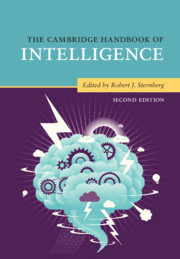Book contents
- The Cambridge Handbook of Intelligence
- The Cambridge Handbook of Intelligence
- Copyright page
- Dedication
- Contents
- Figures
- Tables
- Contributors
- Preface
- Part I Intelligence and Its Measurement
- 1 The Concept of Intelligence
- 2 A History of Research on Intelligence
- 3 A History of Research on Intelligence
- 4 An Alternative View on the Measurement of Intelligence and Its History
- 5 Factor-Analytic Models of Intelligence
- Part II Development of Intelligence
- Part III Intelligence and Group Differences
- Part IV Biology of Intelligence
- Part V Intelligence and Information Processing
- Part VI Kinds of Intelligence
- Part VII Intelligence and Its Role in Society
- Part VIII Intelligence and Allied Constructs
- Part IX Folk Conceptions of Intelligence
- Part X Conclusion
- Author Index
- Subject Index
- References
5 - Factor-Analytic Models of Intelligence
from Part I - Intelligence and Its Measurement
Published online by Cambridge University Press: 13 December 2019
- The Cambridge Handbook of Intelligence
- The Cambridge Handbook of Intelligence
- Copyright page
- Dedication
- Contents
- Figures
- Tables
- Contributors
- Preface
- Part I Intelligence and Its Measurement
- 1 The Concept of Intelligence
- 2 A History of Research on Intelligence
- 3 A History of Research on Intelligence
- 4 An Alternative View on the Measurement of Intelligence and Its History
- 5 Factor-Analytic Models of Intelligence
- Part II Development of Intelligence
- Part III Intelligence and Group Differences
- Part IV Biology of Intelligence
- Part V Intelligence and Information Processing
- Part VI Kinds of Intelligence
- Part VII Intelligence and Its Role in Society
- Part VIII Intelligence and Allied Constructs
- Part IX Folk Conceptions of Intelligence
- Part X Conclusion
- Author Index
- Subject Index
- References
Summary
Psychometrics is the science of psychological measurement. For an intelligence test to be considered valid, it must be evaluated using the principles and methods of psychometrics. In this chapter we introduce basic psychometric techniques such as factor analysis and review the evolution of psychometric theories of intelligence, with emphasis on the Cattell-Horn-Carroll theory of cognitive abilities.
- Type
- Chapter
- Information
- The Cambridge Handbook of Intelligence , pp. 75 - 98Publisher: Cambridge University PressPrint publication year: 2020
References
Accessibility information
- 2
- Cited by

